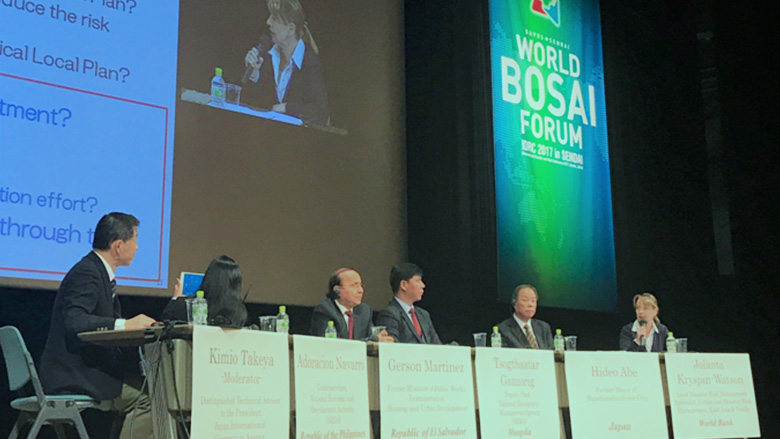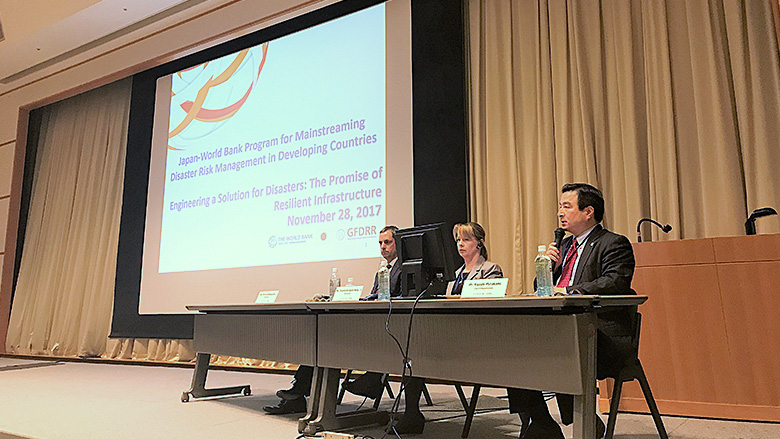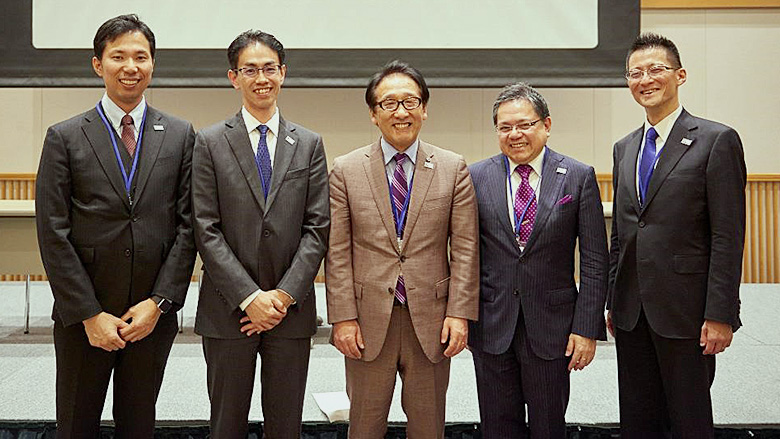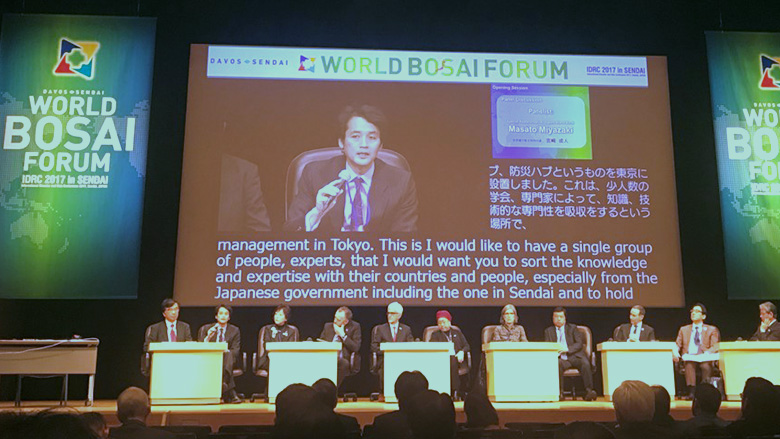More than 900 participants from national and local governments, academia, private sector, international organizations, and civil society from around the world gathered in Sendai, Japan from 26-28 November 2017 for the “World Bosai Forum (WBF): International Disaster Risk Conference”, the first edition of a biannual conference organized in collaboration with the International Disaster Risk Conference (IDRC) in Davos Switzerland.
“Bosai (防災)” is a Japanese word that is comprised of characters that signify “prevention (bo: 防)” of “disasters (sai: 災).” However, the actual concept of “Bosai” in Japan is widely understood and utilized more comprehensively – going beyond simply “disaster prevention” but also bringing together disaster risk reduction, preparedness, and response, encompassing comprehensive efforts that are essential to disaster risk management (DRM).
Sendai is a global leader city in promoting the importance of “Bosai” in the world; as the city valiantly rebuilds and recovers from the 2011 Great East Japan Earthquake and Tsunami, Sendai is also making significant contributions to strengthen international cooperation and exchanges on disaster risk reduction. In 2015, Sendai hosted the Third United Nations World Conference on Disaster Risk Reduction (WCDRR) which led to the endorsement of Sendai Framework for Disaster Risk Reduction 2015-2030 (Sendai Framework). Furthermore, together with various stakeholders, the city is working towards bringing together Japanese and international stakeholders to share knowledge and experiences on DRM. The World Bosai Forum, which is now planned to be held in Sendai every two years, builds on Sendai’s efforts to further its engagements and leadership on DRM in Japan and globally.

At the Forum, the World Bank (WB) partnered with key Japanese DRM stakeholders to engage in discussions and showcase collaborative efforts on mainstreaming “Bosai” within WB operations as well as through support to the Asia-Pacific Economic Cooperation (APEC) Finance Minister process on Disaster Risk Finance (DRF).
World Bosai Forum Opening Ceremony
Mr. Masato Miyazaki, Special Representative of the World Bank in Japan participated in the World Bosai Forum’s Opening Ceremony on Sunday, November 26th. During the ceremony, children and youth from areas affected by the March 2011 disasters shared lessons they experienced from the magnitude 9 earthquake and tsunami, which left more than 15,000 people dead and many still unaccounted for. Students from Otsuchi High School in Iwate Prefecture explained their efforts to chronicle — through photos taken from fixed observation points — the process of reconstructing the town of Otsuchi.
Mr. Miyazaki highlighted how the World Bank is implementing Sendai Framework in its projects, investing in analytics and research to make disaster risk information open, accessible, understandable, and usable by developing countries, and scaling up disaster risk reduction efforts advancing investments through innovative thematic initiatives on resilient transport infrastructure and safer schools.
JICA Session on Investing in Disaster Risk Reduction for Sustainable Development
Ms. Jolanta Kryspin-Watson, World Bank Lead DRM Specialist for Asia and Pacific Region, participated in a panel discussion hosted by JICA entitled, “Investing in Disaster Risk Reduction for Sustainable Development.” The objective of the session was to discuss practical solutions which can be applied globally at the national, regional and local level for increasing investments in disaster risk reduction by sharing experiences and discussion among panelists. Together with government leaders from Philippines, El Salvador, and Mongolia, Ms. Kryspin-Watson showcased World Bank’s comprehensive support to the governments on mainstreaming DRM – by not only supporting disaster resilient, high quality infrastructure investments but also stressing the importance of complimenting these hard investments with soft approaches – including developing an enabling policy environment, strengthening the governance capacities, increasing stakeholder awareness, and promoting inclusive planning and implementation.
The World Bank Tokyo DRM Hub Session on Resilient Infrastructure
The World Bank Tokyo DRM Hub organized a session on “Engineering a Solution for Disasters: The Promise of Resilient Infrastructure.” Through this session, Mr. Francis Ghesquiere, Manager of Global Facility for Disaster Reduction & Recovery (GFDRR), Ms. Jolanta Kryspin-Watson, WB Lead DRM Specialist, and Mr. Kiyoshi Murakami, Deputy Mayor of Rikuzentakata City discussed why mainstreaming disaster risk management was important in strengthening resilience and what were some of the good practices and lessons learned from efforts they have been engaged.
In his remarks, Mr. Ghesquiere pointed out that today, the World Bank invests more than US$5 billion annually to support developing countries building disaster resilience. On resilient infrastructure engagements, the WB’s Global Program for Safer Schools, is partnering with a range of academic, civil society, and development actors, and is working to ensure safer learning environments and minimized disruption to educational services for millions of students. Mr. Ghesquiere also emphasized how the Bank is working closely with the Government of Japan on scaling up investments in other high-quality, disaster-resilient infrastructure including roads and railways as well as advancing best practices on dam safety and disaster resilience for South Asia and East Asia and Pacific regions.
Moreover, Ms. Kryspin-Watson shared her experiences on key challenges and opportunities to mainstreaming disaster and climate resilience in infrastructure investments in East Asia and Pacific region including specific engagements being advanced by the World Bank to reinforce financial resilience, conduct multi-hazard assessments, and strengthening the building regulatory framework in the region.
During his intervention, Mr. Murakami showcased the experience of Rikuzentakata’s local government’s response and recovery from the devastating Great East Japan Earthquake and Tsunami in 2011. His remarks focused on the different roles of the national and local governments and their collaborative mechanisms in emergency social assistance after the disaster. Lessons from the disaster response are now integrated in the city’s masterplan system as a preparedness measure against future disasters.
The session showcased World Bank and Japan’s joint efforts and further commitments through the Japan-World Bank Program for Mainstreaming Disaster Risk Management in Developing Countries, and the Tokyo DRM Hub, to continue supporting developing countries across the globe in making infrastructure investments more resilient through financial and technical support.

APEC related session, “A Disaster-Resilient Community in the Asia-Pacific: The Power of Science and Insurance”
Mr. Hideaki Hamada, Senior Financial Sector Specialist of the World Bank Disaster Risk Insurance and Financing Program (DRFIP), presented recent WB activities that assist in the development of regional catastrophe risk insurance pools such as Pacific Catastrophe Risk Assessment and Financing Initiative (PCRAFI) and Southeast Asia Disaster Risk Insurance Facility (SEADRIF), at the session “A Disaster-resilient Community in the Asia-Pacific: The Power of Science and Insurance,” co-organized by Tokio Marine & Nichido, Asia Pacific Financial Forum (APFF), and International Research Institute of Disaster Science (IRIDeS) at Tohoku University.

Mr. Hamada contributed operational perspectives and experiences of the WB’s engagement in managing sovereign risks through developing and implementing disaster risk financing instruments including regional catastrophe risk pools backed up by parametric models built upon state-of-art risk assessment tools.
At the keynote speech, Dr. Fumihiko Imamura, Director of IRIDes and WBF Committee Chairperson, presented the state of the art technology to forecast tsunamis, which was developed after the Great East Japan Earthquake and Tsunami in 2011. Mr. Daiho Fujii, Director of Research Division in International Bureau, Japanese Ministry of Finance, emphasized the importance of building disaster resilience in a comprehensive manner ex ante disasters, introducing how the earthquake insurance in Japan incentivizes household to build quake resistant houses and contributed to prompt disaster recovery after the Great East Japan Earthquake. Dr. Julius Caesar Parrenas, APFF Coordinator, presented the risk layering approach of DRFI demonstrating the recent innovative programs in the Philippines. Mr. Masaaki Nagamura, Division Head of Corporate Social Responsibility from Tokio Marine & Nichido, shared the various roles that private insurance companies can play – not only in the context of post disaster insurance payouts but also for mitigating the disaster risk.
The session closed with the adoption of a statement proposed by the session panelists that calls upon the global community for a set of four concrete actions below:
- Raise public awareness on disaster risks, making the most of scientific and practical knowledge and experiences inherited, to create disaster-resilient communities.
- Let “PPAP (Public-Private-Academia Partnership)” thrive to develop effective disaster risk management systems and create disaster-resilient communities.
- Encourage the flow of scientific and practical knowledge and experiences into designing creative and sustainable disaster risk financing and insurance (DRFI) mechanisms.
- Invigorate the discussion on DRFI at the Asia-Pacific Economic Cooperation (APEC) Finance Ministers’ Process (FMP), with the support of the Asia-Pacific Financial Forum (APFF) as a platform to convene multi-stakeholders, to achieve the goals set at the Cebu Action Plan, while contributing to the relevant global initiatives such as the Sustainable Development Goals and the Sendai Framework for Disaster Risk Reduction 2015-2030.
The outcome of this session was extremely significant and timely, as it directly builds on, and contributes to, the World Bank’s ongoing partnership with Japan Ministry of Finance and private sector on DRFI at the Asia-Pacific Economic Cooperation (APEC). Given their high exposure to risks of natural disasters, advancing comprehensive financial risk management against disasters is a common and urgent interest of Finance Ministers in APEC member economies. In 2018, APEC Working Group on DRFI under the chairmanship of the Philippine and co-chairmanship of Japan is planning to organize a workshop to explore how to implement national arrangements of domestic disaster risk insurance programs and funding mechanisms for disaster response through social protection systems. It is expected that the workshop will be hosted in one of the APEC countries, such as Tokyo, Japan, with support from WB DRFIP and Tokyo DRM Hub.
About the World Bank Group’s Disaster Risk Financing and Insurance Program
The Disaster Risk Financing and Insurance Program (DRFIP) helps developing countries address the potentially high cost from disasters and climate shocks. DRFIP provides analytical and advisory services, convening services, and financial services to over 50 countries worldwide to support the development and implementation of comprehensive financial protection strategies against climate and disaster risks. To view an introductory video on disaster risk financing, click here. For more information, visit https://www.worldbank.org/en/programs/disaster-risk-financing-and-insurance-program.
About the Japan–World Bank Mainstreaming Disaster Risk Management Program and the Tokyo Disaster Risk Management Hub
The Japan–World Bank Program for Mainstreaming Disaster Risk Management in Developing Countries, launched by the Government of Japan and the World Bank in 2014, supports technical assistance, pilot projects, thematic initiatives, knowledge mobilization, and capacity building along the four pillars of the DRM framework described in the Sendai Report. The program is managed by the Global Facility for Disaster Reduction and Recovery (GFDRR) and implemented by the Tokyo Disaster Risk Management Hub (DRM Hub).
For example, the DRM Hub has worked on showcasing Japan’s global leadership in protecting cultural heritage sites from natural hazards, scaling up seismic risk reduction that are so prominent in Tokyo and many cities across Japan, and ensuring that preparedness efforts are inclusive, well understood and actionable by all stakeholders.

